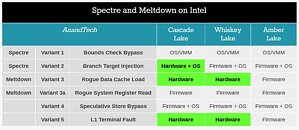Thursday, August 30th 2018

Intel Explains Key Difference Between "Coffee Lake" and "Whiskey Lake"
Intel "Whiskey Lake" CPU microarchitecture recently made its debut with "Whiskey Lake-U," an SoC designed for Ultrabooks and 2-in-1 laptops. Since it's the 4th refinement of Intel's 2015 "Skylake" architecture, we wondered what set a "Whiskey Lake" core apart from "Coffee Lake." Silicon fabrication node seemed like the first place to start, with rumors of a "14 nm+++" node for this architecture, which should help it feed up to 8 cores better in a compact LGA115x MSDT environment. Turns out, the process hasn't changed, and that "Whiskey Lake" is being built on the same 14 nm++ node as "Coffee Lake."
In a statement to AnandTech, Intel explained that the key difference between "Whiskey Lake" and "Coffee Lake" is silicon-level hardening against "Meltdown" variants 3 and 5. This isn't just a software-level mitigation part of the microcode, but a hardware fix that reduces the performance impact of the mitigation, compared to a software fix implemented via patched microcode. "Cascade Lake" will pack the most important hardware-level fixes, including "Spectre" variant 2 (aka branch target injection). Software-level fixes reduce performance by 3-10 percent, but a hardware-level fix is expected to impact performance "a lot less."
Source:
AnandTech
In a statement to AnandTech, Intel explained that the key difference between "Whiskey Lake" and "Coffee Lake" is silicon-level hardening against "Meltdown" variants 3 and 5. This isn't just a software-level mitigation part of the microcode, but a hardware fix that reduces the performance impact of the mitigation, compared to a software fix implemented via patched microcode. "Cascade Lake" will pack the most important hardware-level fixes, including "Spectre" variant 2 (aka branch target injection). Software-level fixes reduce performance by 3-10 percent, but a hardware-level fix is expected to impact performance "a lot less."

32 Comments on Intel Explains Key Difference Between "Coffee Lake" and "Whiskey Lake"
As for product names, look out for Intel Flacca Lake, it'll make you lose your mind :laugh:
And yes, while these timing attacks might be easy to "exploit" in test cases, they are hard to exploit for something useful. It seems like most of these may be leaking a few bytes at the time, some may not work reliably, and may not even be able to target arbitrary addresses. And even then, we are still talking about just a few bytes/sec for a thread eating up a core, so if your plan was to dump the memory of an Amazon EC2 hypervisor, let's say 1 TB of data, you're going to be busy for a while. Memory in the OS kernel is divided into small blocks called pages, and even if you manage to dump most of these intact, you still have the problem of the page table constantly changing while dumping, so you essentially have no way of reassembling it, and any useful data you can find have to be limited to single memory pages which are readable without the rest of the file. Bugs are of course bad and should be fixed, but we're still talking about an absolute edge case here, which will be much harder to execute successfully in uncontrolled environments.
www.itwire.com/security/84056-openbsd-chief-says-more-intel-cpu-flaws-likely-to-be-found.html
As for the naming schemes,I was hoping that one of them would clean up up posts and type / input what I intende but screwed up cuz was "into the cups" and had a few.